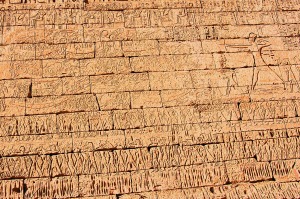Ramses III ruled Egypt from 1186 B.C. until his death in 1155 B.C. Colorful columns in the hypostyle hall of his 150-meter-long temple near Luxor show Ramses among the gods. Statues in a courtyard portray him as Osiris, god of the afterlife. Wall carvings show him delivering enemies to Amun, Egypt’s highest god at the time.
The most famous carvings are on the north exterior wall. They portray Ramses, bow stretched, and his troops battling a confederation of invading “sea people,” predominantly people the Egyptians called “Pelesets” and the Bible calls “Philistines.” The carvings show the Philistines riding three-man chariots pulled by two horses, wielding double edged swords and long spears, carrying round shields and wearing feathered headdresses. According to the hieroglyphic account, Ramses defeated the invaders, taking many of them prisoner. The carvings also show women and children in ox carts, suggesting an entire population on the move.
Most scholars believe the sea people described at Medinet Habu left the Aegean Sea area in about 1200 B.C. for reasons unknown and sought to settle in Egypt. After Ramses III beat them back, they moved into nearby areas. The Philistines took what is now the Gaza Strip area along the eastern Mediterranean coast. According to the Bible, as the Israelites entered their Promised Land they stayed clear of the Philistines, apparently because of their superior iron weapons and fighting skill. The Philistines later moved aggressively into Israel’s heartland until young David killed their champion Goliath and they retreated to five cities along the coast.
The Philistines are remembered today in the name “Palestine,” first used by Herodotus in the fifth century B.C. to describe the area that is now Israel. They are also remembered on the wall at Medinet Habu for battles that help shed light on much more recent events.
